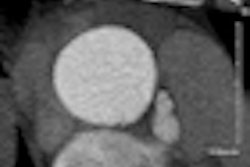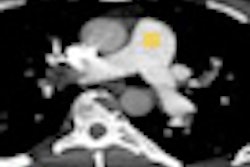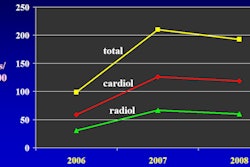Several commonly used measures for estimating radiation dose did not correlate well with actual radiation measurements during complex endovascular repair procedures, and at least one measure should not be used, according to a new article in the Journal of Vascular Surgery.
Researchers from the Cleveland Clinic Foundation found that commonly used surrogate markers for estimating radiation dose, including cumulative air kerma, kerma area product, and fluoroscopy time, did not correlate well with direct measurements of peak skin dose during endovascular thoracoabdominal aneurysm (eTAAA) procedures. Authors of the study included Dr. Giuseppe Panuccio and Dr. Roy Greenberg (J Vasc Surg, April 2011, Vol. 53:4, pp. 885-894).
The authors recorded the three surrogate dose markers concurrently with direct measurements of peak skin dose and radiation exposure patterns using radiochromatic film placed in the back of the patient during the procedures. Operator exposure was assessed using high-sensitivity electronic dosimeters, and the study team calculated the correlation between direct and indirect parameters of radiation exposure.
Finally the group reproduced the observed exposure patterns in phantoms packed with more than 200 dosimeters placed in mock organs, also calculating effective doses in vivo. No patients developed evidence of radiation-induced skin injury during the procedures.
The results showed that peak skin dose was weakly correlated with fluoroscopy time; therefore, fluoroscopy time should not be used to estimate peak skin dose, the authors wrote. Peak skin dose was better correlated with cumulative air kerma and kerma area product, but these parameters still may be poor surrogate markers for radiation dose.
The researchers found that the average effective calculated dose for the endovascular procedure ranged from 78 to 120 mSv based on the type of eTAAA procedure. Operator exposure averaged 0.17 mSv per case, meaning that that operators could perform up to 294 eTAAA procedures annually before reaching the maximum operator dose of 50 mSv per year.



















